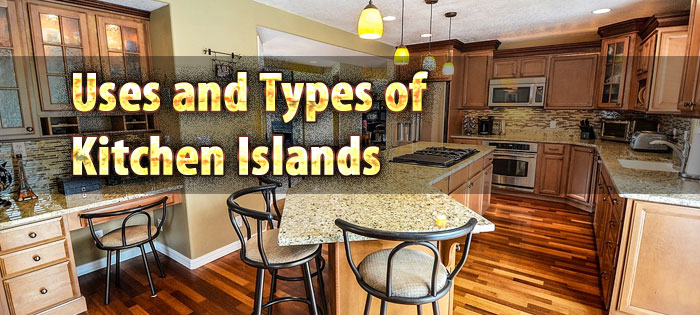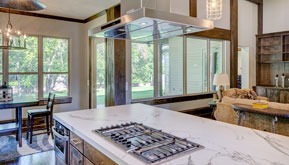Every kitchen has the potential for great storage, design and functionality but not all homeowners are achieving this. Placing a kitchen island could help with this. It surely does add versatility in the kitchen while doing it in style.
You probably think that you need a spacious huge space to accommodate a kitchen island, but actually, all you need is ample space for it to be functional. The size totally depends on you.
Uses of Kitchen Islands
Now if you have enough space and are thinking of getting an island for your kitchen, determine how you want to use your island. Here are some of the uses for kitchen islands:
1. Extension of the dining area
An island with a side designed for dining is a perfect way to host a few diners, while you may be working at the stove or sink. It can be a place to dine informally, like snacks in-between meals or late dinners, especially when you don’t need your larger dining table to accommodate people. It can also be the breakfast spot for your family on weekdays, especially if you don’t eat together at once because of your different school and work schedules.
2. Extra storage space
Kitchen islands have an option for additional shelving and cabinetry to give you extra storage. It’s a great place to store everyday kitchen essentials like those pots, knives, and table napkins; as well items for special occasions such as platters and birthday candles. The countertop can also serve as the designated spot for your small appliances such as blender, bread toaster, microwave oven or coffee maker, especially if you have electrical outlets installed in your island.
3. Extra workspace facility
So you’re preparing for a house party and you’re cooking many dishes at a time. The area around your stove must be pretty crowded. All those cutting, slicing, mixing and other food preparation work could be done in the countertop of a kitchen island. This gives you a workspace within arm’s reach from the stove, oven or other kitchen gadgets you use for cooking.
Or perhaps you want to use the kitchen island as a place for cooking itself or for washing the dishes. If you would install the stove and oven or the sink in your island, it would be easier for you to interact with other members of the family while you do kitchen work.
3. Children’s hangout area
Whether it’s time for homework or for pitching in to help make dinner, a kitchen island is a perfect area for kids to get them in your close eye view and to make them feel part of the action. Even if you are busy and focused with your cooking, you can still have a one-on-one session with the kids while they are situated on the kitchen island. It’s also a great place to store their after-school snacks so they can easily eat and prepare their own food if they want to.
4. Gathering area
No matter how hard you worked for cleaning and decorating all the other parts of the house before a party, most of your guests would spend a lot of time huddled in the kitchen. The kitchen island is the top spot for hanging out; you could turn it into a bar with glasses and drinks lined up, ready for guests to serve themselves. When there’s no party, it becomes a great spot for the family to hang out together.
5. Office desk and table
If your home is lacking in office space and you’re a work-at-home mom, a kitchen island could be the perfect area to set up your laptop, router and telephone. This would not only help you create an easy transition from your mommy tasks to work responsibilities, but it can also keep your dining table and counters free of bills, mail and other paper clutter by keeping them focused on the kitchen island area. If your a student or a College Essay Writer you may well use the kitchen island everyday to get your work done.
 Types of Kitchen Islands
Types of Kitchen Islands
When you have chosen what purposes you would like a kitchen island to serve, then you can decide on what type to get for your kitchen.
Generally, kitchen islands can be categorized as fixed or movable.
Movable types
Although some people may not consider movable items as “real” kitchen islands; it works for those lacking in space or those with budget constraints. These types are easier to afford and “install.”
1. Rolling cart island
Need extra counter and storage space? Get a butcher block cart and make it your movable kitchen island. Some probably don’t even classify carts as a kitchen island, but they work as portable preparation areas and storage, like other kitchen islands do. If you need counter space, you can move them close to your kitchen work area; and if you need more room, you can put it aside. If you use it as an office space, you can simply roll it to another room if you’re hosting a party.
Rolling cart islands help you maximize space, making it ideal for smaller kitchens. Because this type of island has wheels, you need to make sure it comes with locks to prevent movement once you’re working on them.
2. Non-portable or furniture style kitchen island
This is an unconventional choice, but it works for some people. This differs from a movable kitchen island since it doesn’t have wheels, and it can look like a built-in countertop with storage cabinets. Some people even use their chest of drawers to serve as a kitchen island.
The advantage of having a furniture-style kitchen island over the rolling one is that it doesn’t have the tendency to slide away when you’re trying to cut something. Meanwhile, its edge over the fixed types is that you don’t have to deal with them as long as you live in your house – you can change its position anytime you like or get rid of them anytime you want to.
3. Kitchen island table
This island has four legs and a flat top – yes, it’s basically a table. But if you position it where an island would usually land, then it’s a kitchen island. It’s nothing more than an extra flat surface for food preparation. It’s easy to bring to and move within your kitchen.
The top surface could serve other kitchen island functions as well, like a place for gathering, dining and entertaining kids. Also, if you’re just lacking countertop space for your kitchen appliances or maybe on-the-go foods like snacks and fruits, then a simple table would do.
Fixed types
If the island is fixed, then it looks more “legit.” Fixed kitchen islands are usually built along with the construction of the whole kitchen, but you can still have it added you need one (just make sure it would complement the rest of your kitchen). It comes in different shapes and styles such as:
- Galley – the most common style; a simple rectangular island opposite the main work area of a kitchen
- L-shaped –shaped like an L; good for larger kitchens
- U-shaped – shaped like a U; usually found in huge kitchens
- Circular – can be shaped like a full circle or half-moon; adds personality to the kitchen layout
- Peninsula – has one side attached to a wall
Fixed kitchen islands can also be single-tiered or double-tiered.
- Single-tier – whole island surface is on just one level. It provides expansive space for any kitchen work.
- Double-tier – has a raised top to provide an upper deck. Usually, the lower part is meant for cooking and other food and drink preparations, while the upper deck is for drinking and dining in tall chairs.
All these can either be of these fixed types:
1. Base cabinet with countertop
This is a basic island made of a base cabinet for storage (usually made of wood), topped with countertop material, such as granite. You can place some chairs on the opposite side to accommodate dining. The base cabinet with countertop is the easiest built-in kitchen island to build.
2. Fully functional kitchen island
When we say fully functional, it has access to electricity and water. The fully functional island has what the primary kitchen countertops have: sink, drainage, electric outlets and ample countertop space. Some also place their stovetop and cooking area on the island. Most double-tiered islands of this type make use of the wall separating two surfaces as an area for switches and outlets.
This type of kitchen island is not just additional counter space; it’s almost an entire second kitchen or a main kitchen part for that matter. If you have a U-shaped island, are you really going to let all of it be auxiliary counter space?


 Types of Kitchen Islands
Types of Kitchen Islands